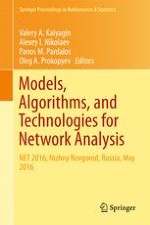This valuable source for graduate students and researchers provides a comprehensive introduction to current theories and applications in optimization methods and network models. Contributions to this book are focused on new efficient algorithms and rigorous mathematical theories, which can be used to optimize and analyze mathematical graph structures with massive size and high density induced by natural or artificial complex networks. Applications to social networks, power transmission grids, telecommunication networks, stock market networks, and human brain networks are presented.
Chapters in this book cover the following topics:
Linear max min fairness
Heuristic approaches for high-quality solutions
Efficient approaches for complex multi-criteria optimization problems
Comparison of heuristic algorithms
New heuristic iterative local search
Power in network structures
Clustering nodes in random graphs
Power transmission grid structure
Network decomposition problems
Homogeneity hypothesis testing
Network analysis of international migration
Social networks with node attributes
Testing hypothesis on degree distribution in the market graphs
Machine learning applications to human brain network studies
This proceeding is a result of The 6th International Conference on Network Analysis held at the Higher School of Economics, Nizhny Novgorod in May 2016. The conference brought together scientists and engineers from industry, government, and academia to discuss the links between network analysis and a variety of fields.
